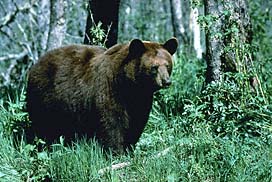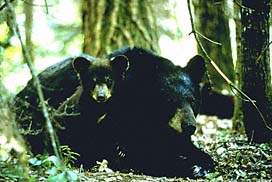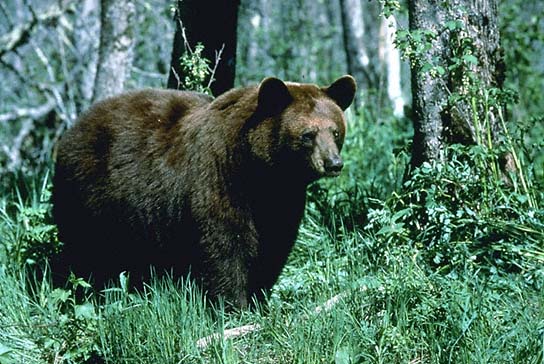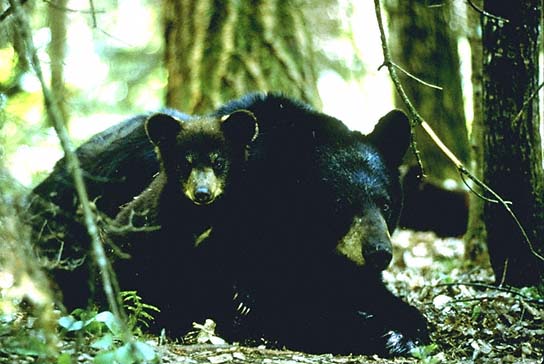Bears
Description
In the East, nearly black; in the West, black to cinnamon, with white blaze on chest. A "blue" phase occurs near Yakutat Bay, Alaska, and a nearly white population on Gribble Island, British Columbia, and the neighboring mainland. Snout tan or grizzled; in profile straight or slightly convex. 3 pairs of upper incisors equal in size. Male much larger than female. Ht 3–3' 5" (90–105 cm); L 4' 6"–6' 2"(137–188 cm); T 3–7" (7.7–17.7 cm); HF 9–14 5/8" (23–37 cm); Wt 203–587 lb (92–267 kg).Endangered Status
The Louisiana Black Bear, a subspecies of the Black Bear, is on the U.S. Endangered Species List. It is classified as threatened in Mississippi, Louisiana, and Texas. Numbers of this bear apparently held steady until European settlement and its attendant population explosion and large-scale habitat alteration. Black Bears were heavily hunted and their woodland habitats were logged and converted to farmland. The Louisiana Black Bear today survives primarily along the Tensas and Atchafalaya River basins in Louisiana, although it wanders farther afield. A recent threat to the Black Bear has been illegal killing and the export of its gall bladders to Asia.Similar Species
Grizzly Bear is usually larger, and has generally somewhat concave facial profile, muscular hump above shoulder region, longer foreclaws, and outer pair of upper incisors much larger than 2 inner pairs.
Breeding
Mates June–early July; litter of 1–5 (usually 2) young born January–early February; birth weight not much over 7 oz (200 g).
Sign
Feeding signs: Logs or stones turned over
for insects; decayed stumps or logs torn apart for grubs; ground
pawed up for roots; anthills or rodent burrows excavated; berry
patches torn up; fruit-tree branches broken; rejected bits of
carrion or large prey, such as pieces of skin, often with head or
feet attached.
Trees: Scarred with tooth marks, often as high as
a bear can reach when standing on its hindlegs; higher, longer claw
slashes, usually diagonal but sometimes vertical or horizontal. In
spring, rub marks and snagged hair on furrowed or shaggy-barked
trees used repeatedly and by several bears as shedding posts, to rub
away loose hair and relieve itching.
Scat: Usually dark brown,
roughly cylindrical, sometimes coiled, similar to that of domestic
dog; often showing animal hair, insect parts, seeds, grasses, root
fibers, or nutshells. Where bears have fed heavily on berries, scat
may be liquid black mass.
Trails: Those used by generations of
bears are well worn, undulating, and marked with
depressions.
Tracks: Broad footprints; 5 toes print on all feet,
although innermost, smallest toe may fail to register. Foreprints 4"
(100 mm) long, 5" (125 mm) wide, turned in slightly at front.
Hindprints 7–9" (180–230 mm) long, 5" (125 mm) wide. Individually
prints (especially hindprints) look as if made by a flat-footed
human in moccasins, except that large toe is outermost. In soft
earth or mud, claw indentations usually visible just in front of toe
marks. Bears have a shuffling gait; hind tracks and front tracks are
paired, with hind track several inches before front track on same
side. Stride about 1'(300 mm) long. Sometimes, when walking slowly,
hindprints either partially or completely overlap foreprints; when
running, hindfeet brought down well ahead, with gaps of 3' (900 mm)
or more between complete sets of tracks.
Habitat
In East, primarily forests and swamps; in West, forests and wooded mountains seldom higher than 7,000' (2,100 m).
Discussion
Although primarily nocturnal, this uniquely North American bear may be seen at any time, day or night. It occupies a range usually of to 10 square miles (20–25 sq km), although sometimes up to 15 square miles (40 sq km). The home range of the male is about double the size of that of the female. The Black Bear’s walk is clumsy, but in its bounding trot it attains surprising speed, with bursts up to 30 mph (50 km/h). A powerful swimmer, it also climbs trees, either for protection or food. Although this animal is in the order Carnivora, most of its diet consists of vegetation, including twigs, buds, leaves, nuts, roots, fruit, corn, berries, and newly sprouted plants. In spring, the bear peels off tree bark to get at the inner, or cambium, layer. It rips open bee trees to feast on honey, honeycombs, bees, and larvae, and will tear apart rotting logs for grubs, beetles, crickets, and ants. A good fisher, the Black Bear often wades in streams or lakes, snagging fish with its jaws or pinning them with a paw. It rounds out its diet with small to medium-size mammals or other vertebrates. In the fall, the bear puts on a good supply of fat, then holes up for the winter in a sheltered place, such as a cave, crevice, hollow tree or log, under the roots of a fallen tree, or, in the Hudson Bay area, sometimes in a snowbank. Excrement is never found in the wintering den. The bear stops eating a few days before retiring, but then consumes roughage, such as leaves, pine needles, and bits of its own hair. These pass through the digestive system and form an anal plug, up to 1 foot (30 cm) long, which is voided when the bear emerges in the spring. Sows mate during their third year, with most producing one tiny cub the first winter, two on subsequent breedings. While the mother sleeps in the den, the almost naked newborns nestle into her fur. The mother often lies on her back or side to nurse, but sometimes sits on her haunches, with cubs perched on her lap, much like human infants; they may nurse for about a year. The female Black Bear is not receptive to males while nursing. This bear is mainly solitary, except briefly during the mating season and when congregating to feed at dumps. Bears are often a problem around open dumps, becoming dangerous as they lose their fear of humans; occasionally people have been killed by them. Hunting Black Bears is a popular sport in some areas, both for the flesh (which must be well cooked because of trichinosis) and the hides, used for rugs. The helmets of Great Britain’s Buckingham Palace guards are made of the Black Bear’s fur.






